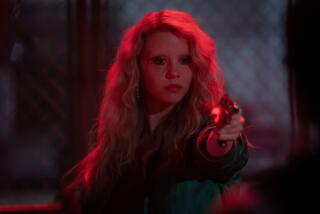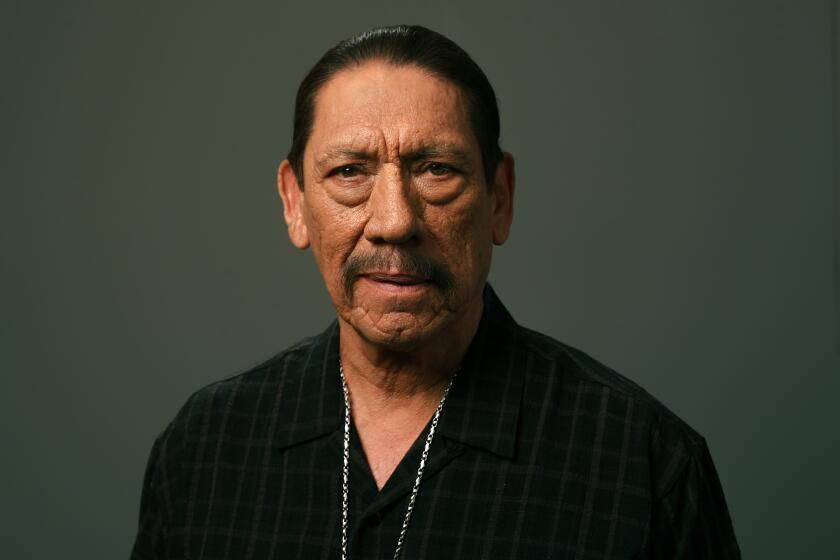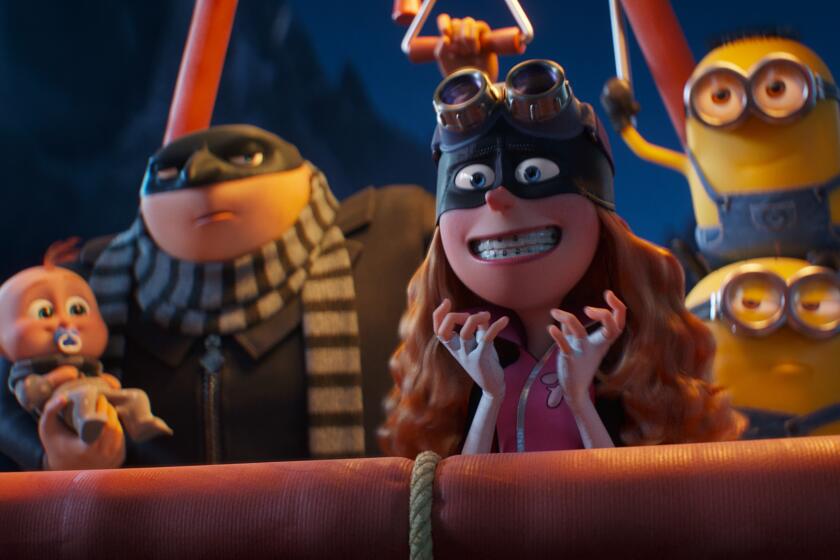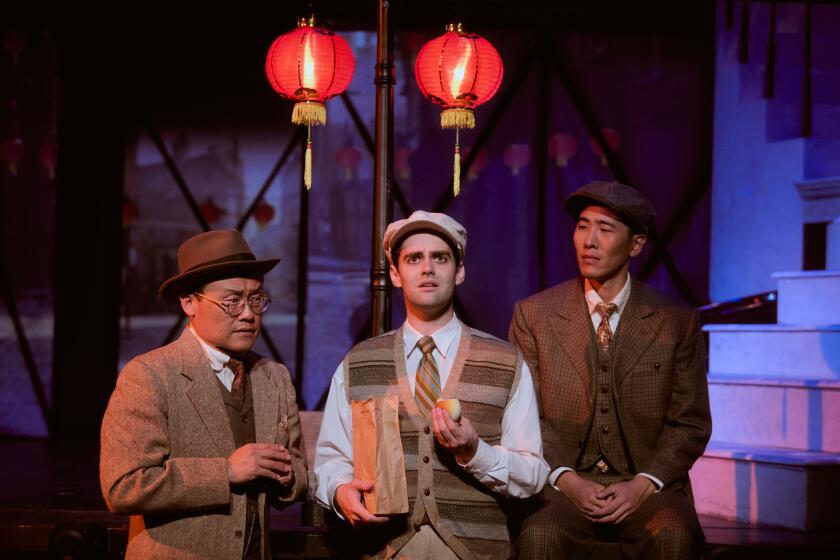ON LOCATION : Bad to the Bone : Rock’s bad boy Mick Jagger hunts bodies from the past to recycle in ‘Freejack’--but don’t call him ‘unsympathetic’
“Villainy,” said Mick Jagger, in the voice that has launched hundreds of Rolling Stones concerts, “could also be called wasted life. A well-organized society would make good use of all the talents within it, rather than letting so many go to waste.”
Jagger had just finished playing Vacendak, a bounty hunter of young bodies and one of the villains in the new science-fiction thriller “Freejack,” filming in sectors of a futuristic New York City that the film company Morgan Creek Productions built in Atlanta.
Then Jagger came to present-day New York City on private business, and cast and crew members came to finish the film.
In the world of “Freejack,” bodies are “snatched” a moment before death and transported to a “snatch lab” 19 years in the future, where the minds and spirits of rich, privileged members of society are transplanted into the young, desirable bodies.
Occasionally, however, the bodies from the past awaken before the mind-body switch occurs, and escape as “freejacks.” When they do, the bounty-hunting Vacendak tracks them down.
“Freejack” was co-written and co-produced by Ron Shusett, 47, who co-wrote and co-produced “Alien” and “Total Recall,” and it’s being directed by New Zealander Geoff Murphy, whose anti-colonial “Utu” was a Cannes Film Festival favorite. Last year, Murphy chronicled the questions surrounding the death of Billy the Kid, one of society’s favorite villains, in “Young Guns II.” Emilio Estevez, who played Billy in both “Young Guns” hits, plays Alex, “the reluctant hero” of “Freejack.”
Estevez’s Alex is a young racing-car driver ostensibly killed in a New York car crash in 1991 who wakes up in 2009 to find that the rich dominate the city even more than they do now. In fact, the richest, McCandless, played by Anthony Hopkins, would just love to beat old age in, rather than over, Estevez’s dead body. Alex evades his body-snatching captors, though, and is pursued throughout the film by Jagger’s Vacendak.
Sitting in a canvas chair on Delancey Street at the entrance to the present-day Williamsburg Bridge, Shusett recalled that the premise for the story originated in a novella by Robert Sheckley called “Immortality, Inc.,” which he read as a theater arts major at UCLA and never forgot. In it, the rich lengthen their lives by buying the bodies of the poor and transferring their minds into younger brains.
To Shusett, this is villainous. “Extending your life at the expense of someone else is immoral,” he said. “Remember the old commercial: Don’t fool with Mother Nature.”
Estevez sits in his trailer beneath the bridge practicing looking dumbfounded, for his primary emotion when Alex wakes up, he says, is wonder--for example, wonder at the 200-story McCandless Building that rises from 42nd and Broadway in 2009 and dominates Manhattan. It exists, of course, only as a combination of matte paintings and partial sets, but Estevez must react as if he is seeing all 200 stories of it, lunging into the sky.
Estevez, too, thinks that villains are often people whose daring and energy of character might have made them heroes in a better-organized society.
“There was a phrase I read in a history book that I used in my interpretation of William Bonney: ‘Billy the Kid was the villainous obstacle to Manifest Destiny.’ In other words, Billy said: ‘I don’t accept your barbed wire.’ ”
Estevez was born in 1962 and is 17 years younger than Jagger, but he can quote “Sympathy for the Devil,” the song that Jagger and Keith Richards wrote in 1968:
I shouted out, “Who killed the Kennedys?, “ cries Estevez.
The song, which makes the point that we are all accomplices in villainy, that when we meet the enemy, we find that he is us, is in the 125th edition of Bartlett’s Familiar Quotations, along with such other experts on villainy as Shakespeare (“One may smile, and smile, and be a villain”) and John Wesley (“That execrable sum of all villainies, commonly called the Slave Trade”).
Fifth-generation New Zealander Murphy, who ascribed villainy to colonialism in “Utu,” sits inside his trailer parked beside the bridge, preparing a “Freejack” scene in which Jagger’s character chases Estevez’s character onto the bridge in futuristic vehicles. All the vehicles, whose cost makes up $500,000 of the production’s $30-million budget, are the imaginative contribution of production designer Joe Alves, who helped give “Jaws” its mechanical shark and “Close Encounters” its mother ship. He made most of them tanklike, as befits a time when none but the rich and the police get around much in cars anymore.
As a Wellington-born schoolteacher in New Zealand, Murphy found that 15-year-olds who were having trouble reading were embarrassed to learn from books written for young children. He tried to prevent their lives from being wasted by illiteracy by “making up a book about a policeman who always got his man but always by accident.”
Murphy’s communication skills led gradually to this parable about the perils of the future in the guise of a sci-fi thriller. “All good sci-fi says that if we’re not careful, this is how we will finish,” Murphy said. “In ‘Freejack,’ we’re extrapolating from existing trends. The rich get richer. The poor get children. The rich abdicate their responsibility to society and withdraw into protected communities. The waterways get more and more polluted.”
He is relying on Estevez, his villain-as-hero from “Young Guns II.” “This business is terribly short on strong young male players. If you think about the ‘50s, there were all those guys like Lancaster and Douglas. Look around today and there’s not the same sort of strength in the males. Emilio is still growing into that mold, but I think he’ll make it.”
Murphy views Jagger more as an icon than an actor. “Jagger didn’t become Jagger for nothing. There’s all that presence.”
Co-producer Stuart Oken confirms that it was Jagger’s icon quality that Morgan Creek wanted for Vacendak. “Mick has as great a presence as anybody you could think of,” Oken says. “You look at his eyes, you look at his mouth, you can see the way his mind works.”
Jagger hadn’t performed in a feature film since he had the title role in Tony Richardson’s “Ned Kelly,” the story of the ill-fated 19th-Century Australian outlaw who fought for the workers against the landowners, and Nicolas Roeg’s “Performance,” both released in 1970. Musical commitments caused him to drop out of “Fitzcarraldo” (1980-81) when illness caused Jason Robards to withdraw. But after completing his European tour in September, 1990, Jagger had been adapting his schedule for more leisure. “ ‘Freejack’ came along at just the right time with just the right elements,” he said.
When Mick Jagger was 5, he remembers, he played cowboys with the kid down the street--Keith Richards. Richards had a Roy Rogers cowboy suit, so naturally he was the hero in the white hat. “I preferred the black outfit, personally,” Jagger said. Today, James Jagger, Mick’s 5-year-old son with model Jerry Hall, plays heroes--four of them: Leonardo, Donatello, Michaelangelo and Raphael--the Teenage Mutant Ninja Turtles. So when they play together, said Mick, “I’m the bad guy.”
Later, when Jagger and Richards teamed up with Brian Jones and became the Rolling Stones, they were cast as the Bad Boys of Rock, “the antithesis of the Beatles.” It was largely marketing, Jagger said. The Beatles were marketed earlier, and they were cast, by Brian Epstein, as “cuddly toys.”
Jagger sounds resigned to the fate that casts some as heroes and others as villains. He reminds us that when Ned Kelly was going to the gallows, his last words were the wistfully resigned, “Such is life.” So Jagger has gone from being a bad boy of rock to a villain in the movies.
“That’s fine with me,” Jagger said. “Think how many actors love to do those roles.” His favorite actor when he was growing up, he said, was Charles Laughton, who often played villains. Jagger cited the corrupt Roman senator that Laughton played in “Spartacus,” who nevertheless arranges the escape of the wife (Jean Simmons) of the condemned rebel leader--out of mixed motives. But if he doesn’t mind being called bad, he doesn’t want to be called “unsympathetic.” For him to play a villain on the screen, Jagger said, “the character has to have some redeeming features.”
“We all have within us some meanness and other bad qualities,” Jagger said. “I don’t see Vacendak as the epitome of villainy at all. He starts out as a guy just doing a job he enjoys. Originally in the script it was just careless killing. But as I play him, Vacendak enjoys the pursuit and he’s good at it. Now, when he catches them, of course, he empties their brains out of their bodies. But his excuse is that these guys are already almost dead.
“I am not a theater-trained actor who can by artifice portray something very easily. So before I played Vacendak, I had to write a ‘back story’ for him, telling myself the story of his life so that I would understand why he behaves as he does. I have him living a life wasted because of his background. I had his parents breaking up, his father is in the military, he starts drifting, he becomes a mercenary. But when he comes down to a very hard choice at the end of the picture, the real villain is revealed.”
He gave Vacendak a sense of humor that the character didn’t have in the script. Moreover, Jagger himself views Vacendak with sardonic humor. “I wanted him to be an addictive personality. I wanted the character to have an addiction. Most everyone has one. But I didn’t want him to be addicted to cigarettes, or alcohol, or drugs. So I had him addicted to eating pan --Indian leaves wrapped around condiments. Pan gives you a little high.”
And so Jagger created perhaps the first pan -addicted villain.
The “Freejack” location resounds with the sense that cast and crew members are living in a time frame defined, to a surprising extent, by the Rolling Stones. Julie, the love interest, is played by Burbank-born Rene Russo, a 37-year-old former model who was discovered at 16 because she disobeyed her mother and went to a Rolling Stones concert in Los Angeles. On the way out, she was stopped by a man who said, “You should model or act. Do you?” “No,” said Rene in an unfriendly tone. “Look, here’s my card,” said the man. “Come see me.” Rene looked at him with the distrust of a girl who had heard about this particular variety of villain. “Look, I’m serious,” a modeling agent told her. “Bring your mother with you.”
At 16 1/2, she was a model, working as the Revlon Girl for the Ford Agency and appearing on the cover of Cosmopolitan and Vogue.
“I realized it was fleeting,” she said. “They’re looking at you just for what’s outside, and you know you can’t hold on to it forever. “But I’m a high-school dropout, and I was getting older, so I’m trying to move on to acting.” She’s in “One Good Cop” opposite Michael Keaton, and now there’s “Freejack” opposite Emilio Estevez, but she is not entranced with the way that either of the woman’s roles are written.
“It’s survival,” she shrugs. “I have to work within the talents I have.”
Up on the Williamsburg Bridge, the crew prepares to film the final moment of the big chase scene. A champagne delivery truck commandered by Alex (Estevez) has rounded a corner with the command vehicle of Vacendak (Jagger) on his tail. Alex approaches a temporary barrier across the road. A sign reads: “Bridge Closed for Repairs.”
Alex’s stolen vehicle crashes through the barrier and hurtles across the bridge, with Vacendak 50 yards behind him. Halfway across, a repair gang is working on the span and heavy machinery completely block the way. Workmen scatter at their approach.
Seeing that he is trapped, Alex angles his truck toward the railing, stands and pops like a cork out of the vehicle and over the side of the bridge into the water as his truck caroms into railing, then machinery and then sends up a giant fireball as it explodes.
The “Freejack” crew threw a dummy into the East River in place of Estevez. Three cameras recorded the moment. Traffic was stopped for five minutes. It quickly backed up along Delancey Street for half a block and started New Yorkers honking with practiced impatience.
Murphy had already shot Estevez jumping out of frame from his truck against blue screen backing, and he had also shot a stunt man jumping over the camera and a fireball going off on a portion of the bridge that they built in Atlanta. But this was the wide shot utilizing the real bridge and real New York sky to show the dummy Alex seeming to leap and the fireball really happening to tie it all together.
But New York City’s East River is playing itself. Jagger, playing Vacendak, looks down in the direction of Estevez’s character in the water below. “You drink any of that water,” the body bounty hunter says sardonically, “and I’m out of a job.”
More to Read
Only good movies
Get the Indie Focus newsletter, Mark Olsen's weekly guide to the world of cinema.
You may occasionally receive promotional content from the Los Angeles Times.






